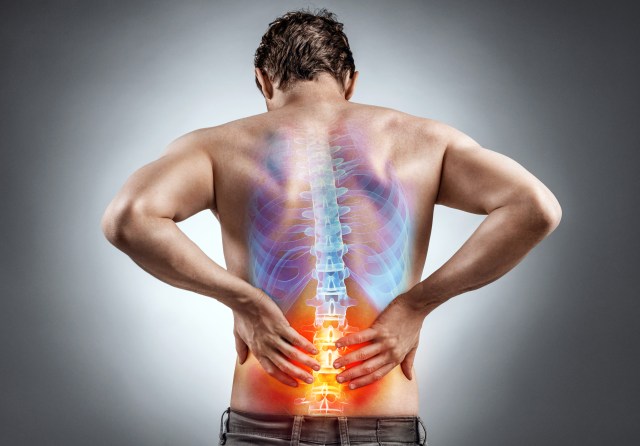Low Back Ache
Lower back pain is experienced by almost everyone at some point of their life. The condition is a cause of injuries, such as a muscle strain or spasm, sprains of ligaments, joint problems, or a slipped disc. A slipped disc happens when the disc between the bones of the spine bulges and presses on the nerves. This often is caused by twisting while lifting. But many people never know what caused their slipped disc. The most common cause of back pain is using your lower back muscles in activities you are not usually engaged in, like lifting heavy furniture or doing yard work.
Suggestions for pain relief:
- The best position for relief when your back hurts is to lie on your back on the floor with pillows under your hips, and knees bent with your feet on a chair, or just with your hips and knees bent. This takes the pressure and weight off your back.
- If you have a hurt back, you may need a day or two of this sort of resting regime. Resting longer that this can cause your muscles to weaken, which can slow your recovery. Even if it hurts, walk around for few minutes every hour.
- Heating pads can help relax painful muscle spasm. Use heat for 20-30 minutes at a time. Ice pack and massages may also give relief.
Relief for ongoing back problem:
Treatment of ongoing back problems must be directed at the cause. This may mean losing weight (because being overweight can make back pain worse), getting your muscles in better shape or improving your posture when you are sitting, standing and sleeping.
- The best position to stand:
If you must stand for long periods, rest a foot on a low stool to relieve pressure on your lower back. Every 5-15 minutes, switch the foot you are resting on the stool. Maintain a good posture by keeping your ears, shoulders and hips in a straight line with your head up and your stomach pulled in.
- The best position to sit:
Sit on a chair with a straight low back support. Keep your knees a little higher than your hips. Adjust the seat or use a low stool to prop your feet on. Turn by moving your whole body rather than by twisting at your waist. When driving, sit straight and move the seat forward. This helps you avoid leaning forward to reach the controls. You may put a small pillow or rolled towel behind your lower back if you‘re driving or sitting for a long time.
- The best position while sleeping:
The best way to sleep is on your side with your knees bent. You may put a pillow under your head to support your neck. You may also put a pillow between your knees.
If you sleep on your back, put pillows under your knees and a small pillow under your lower back. Do not sleep on your stomach unless you put a pillow under your pelvis.
Use a firm mattress. If your mattress is too soft, put a board of half-inch plywood under the mattress to add support.
Exercises that help strengthen the back:
Some specific exercises can help relieve pain of your lower back. One of them is lying on your back with your knees bent while gently stretching your back muscles. Slowly raise your left knee to your chest. Press your lower back against the floor. Hold for 5 seconds. Relax and repeat the exercise 5-10 times for each leg while switching.
While some exercises are specific for your back, it is also important to stay active in general. Swimming and walking are good exercises to improve your overall fitness.
Some useful exercises for back-
- Knee-to-chest: Lie on your back with both legs straight. Bring one knee into your chest, pressing into the floor (pelvic-tilt). Hold for 5 seconds and release. Do this with the other leg and repeat 5 times.
- Double knee-to-chest stretch: Lie down on your back. Pull both knees over your chest until you feel a comfortable stretch in your lower back. Keep your back relaxed. Hold for 45-60 seconds.
- Curl-up exercise: Lie on your back on the floor while keeping your arms folded across your chest, tilt your pelvis to flatten the back. Tuck your chin into your chest. Tighten your abdominal muscles while raising head & shoulders from the floor. Hold for 10 seconds and release. Repeat 10-15 times. Gradually increase your repetitions.
- Pelvic tilt: Lie on your back with your knees bent. In this relaxed position, the small part of your back will not be touching the floor. Tighten your abdominal muscles so that your back presses flat against the floor. Hold for 5 seconds then relax. Repeat 3 times. Gradually increase the repetitions to 10.
- Alternate arm-leg extension exercise: Face the floor with your hands and knees bent. Raise your left arm and right leg. Do not arch your neck. Hold for 10 seconds and release. Repeat this with your right arm and left leg.
- Back stretch: Lie on your stomach. Use your arms to push your upper body off the floor. Hold for 5 seconds. Let your back relax and sag. Repeat 10 times.

